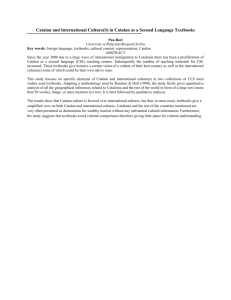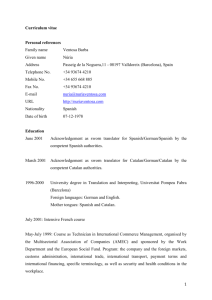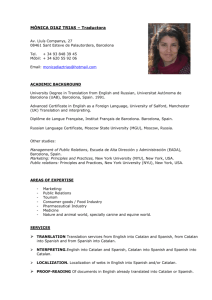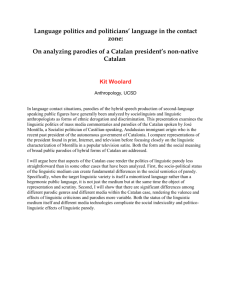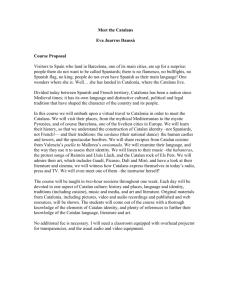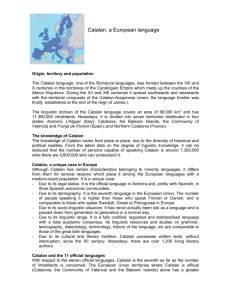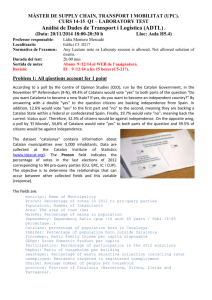The studies carried out by the Andorran Administration as a point of
advertisement
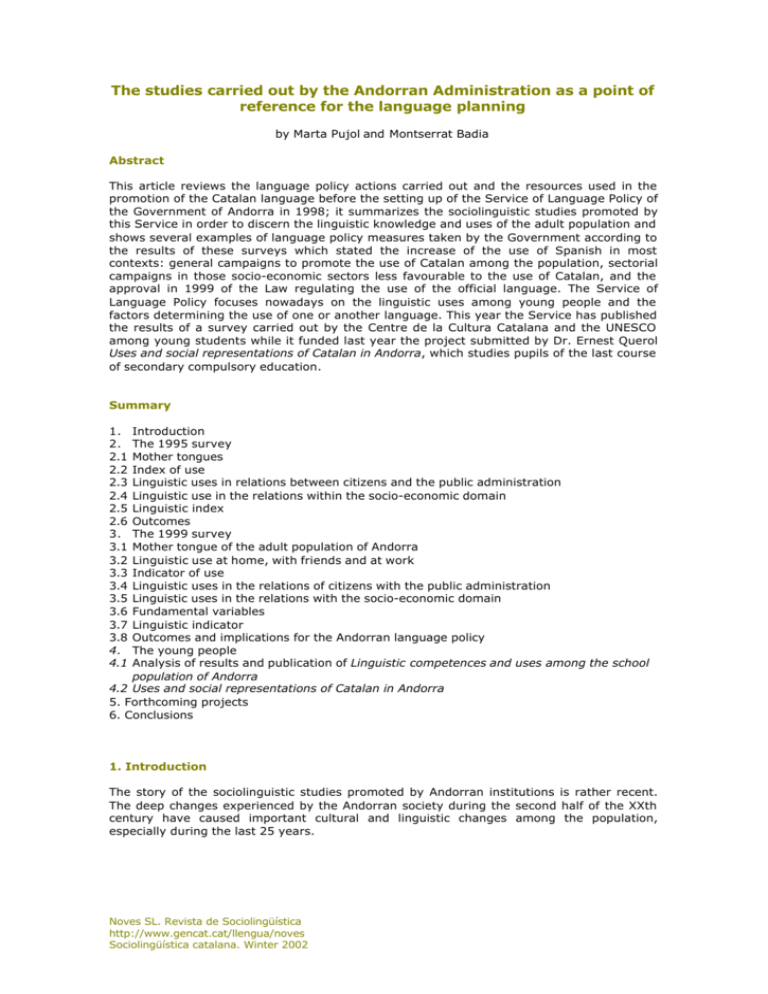
The studies carried out by the Andorran Administration as a point of reference for the language planning by Marta Pujol and Montserrat Badia Abstract This article reviews the language policy actions carried out and the resources used in the promotion of the Catalan language before the setting up of the Service of Language Policy of the Government of Andorra in 1998; it summarizes the sociolinguistic studies promoted by this Service in order to discern the linguistic knowledge and uses of the adult population and shows several examples of language policy measures taken by the Government according to the results of these surveys which stated the increase of the use of Spanish in most contexts: general campaigns to promote the use of Catalan among the population, sectorial campaigns in those socio-economic sectors less favourable to the use of Catalan, and the approval in 1999 of the Law regulating the use of the official language. The Service of Language Policy focuses nowadays on the linguistic uses among young people and the factors determining the use of one or another language. This year the Service has published the results of a survey carried out by the Centre de la Cultura Catalana and the UNESCO among young students while it funded last year the project submitted by Dr. Ernest Querol Uses and social representations of Catalan in Andorra, which studies pupils of the last course of secondary compulsory education. Summary 1. 2. 2.1 2.2 2.3 2.4 2.5 2.6 3. 3.1 3.2 3.3 3.4 3.5 3.6 3.7 3.8 4. 4.1 Introduction The 1995 survey Mother tongues Index of use Linguistic uses in relations between citizens and the public administration Linguistic use in the relations within the socio-economic domain Linguistic index Outcomes The 1999 survey Mother tongue of the adult population of Andorra Linguistic use at home, with friends and at work Indicator of use Linguistic uses in the relations of citizens with the public administration Linguistic uses in the relations with the socio-economic domain Fundamental variables Linguistic indicator Outcomes and implications for the Andorran language policy The young people Analysis of results and publication of Linguistic competences and uses among the school population of Andorra 4.2 Uses and social representations of Catalan in Andorra 5. Forthcoming projects 6. Conclusions 1. Introduction The story of the sociolinguistic studies promoted by Andorran institutions is rather recent. The deep changes experienced by the Andorran society during the second half of the XXth century have caused important cultural and linguistic changes among the population, especially during the last 25 years. Noves SL. Revista de Sociolingüística http://www.gencat.cat/llengua/noves Sociolingüística catalana. Winter 2002 The studies carried out by the Andorran Administration as a point of reference for the language planning Up till then the General Council (Consell General, i.e. the government) and many municipalities had to pass legislation, in their respective domains of competences, on various cases or contexts in which the language to be used was unclear. The agreement of the General Council dating from the end of the 19th century (1898) via which the síndic ordered that “passports and guides should be printed in the Catalan language and not in Spanish, because the former is the own language of the Valleys” shows that the ambiguity in the use of languages is a long-standing theme and is not related only to the most recent immigration. Nevertheless, the directives issued to regulate on some irregular use of the language (mainly in labelling, advertisements or documents submitted to the Andorran administration) was for many years a useful and adequate tool assisting Catalan to hold the place which corresponds to it as the official language. During the eighties the resources devoted to language policy were clearly insufficient and it was this, probably, which led to the creation of two fundamental institutions for the promotion of Andorran culture and the integration of immigrants: the most relevant was the setting up of the Andorran education system from the school year 1982-1983, while the second one was the creation in 1988 of the language policy service to support private companies and commerce in the use of Catalan, to improve the level of knowledge of the official language among the population and to promote its use according to the article 2.1. of the Constitution and the directives of the General Council regulating the use of Catalan. After an initial settling-in phase of this service, which for the first time provided resources in domains other than that of education, the Andorran government expressed the need to analyse the sociolinguistic situation in-depth. This was the origin of the survey on uses and linguistic knowledge of the population in Andorra carried out in 1995. Previously, other studies had analysed the Andorran situation from different perspectives, for example Lixfeld's work on “The relationship between social and linguistic structures in a multiethnic state” (an author’s study that made relevant contributions), or the better known study by Boix & Farràs on use, competence and linguistic ideologies in Andorran high schools, which focused on young people and combined both quantitative and qualitative analysis. Furthermore, the population census was carried out in 1989 and two questions were included on the languages spoken at home. Unfortunately, the results were hardly useful due to the low number of replies. 2. The 1995 survey Despite of the relevance and value of all the studies carried out previously by different researchers, Andorran experts worried about the tendency to assimilate or make too hasty comparisons between the Andorran situation and that of Catalonia which was quite different from both psychological and sociological points of view, especially at that time. For this reason, the highest priority of the survey was that it should be undertaken by Andorran experts who nonetheless could be advised by Catalan specialists. This surveys was aimed at providing the first sociolinguistic picture of the adult population of Andorra as a whole. The study was entitled Usos i coneixements lingüístics de la població d’Andorra. Its technical characteristics and main results are described below : Noves SL. Revista de Sociolingüística http://www.gencat.cat/llengua/noves Sociolingüística catalana. Winter 2002 2 The studies carried out by the Andorran Administration as a point of reference for the language planning Territorial scope Universe Sample size Sampling method Absolute margin of error Type of interview Fieldwork 1995 Survey All the municipalities of Andorra Residents in Andorra aged 14 and over. 1,016 surveys First, the place of residence of the interviewee was selected according to randomised routes and then the interviewees were chosen according to the quota method. The sample was stratified by gender, nationality and place of residence (municipality). ±3,1% Error calculated for a probability below 95% if P=Q=50%. Approximately 25/30 minutes-long personal interview based on a previously structured questionnaire. Undertaken from September 11 to October 10, 1995 by a team of 19 interviewers. 2.1 Mother tongues The distribution percentages of the population according to the mother tongues established in this first survey were as follows: Catalan Spanish French Portuguese English Other 42.7% 34.6% 18.8% 10.7% 1.7% 4.8% 2.2 Index of use The frequency of use of each of the languages in each situation was evaluated according to a scale ranging from 1 to 5: 1 meaning "n", 2 "little", 3 "from time to time", 4 "quite often" i 5 "very often". To set up the indicator of use we took into account the relations within the household, with friends and at work as these activities constitute the fabric of daily life, and later on a weighted average was established between the frequencies of use in these domains. The results were: Catalan Spanish French Portuguese 3.4 2.7 1.4 1.3 2.3 Linguistic uses in relations between citizens and the public administration In order to analyse these uses we asked the interviewees which language they used in their relations with the governmental offices, municipalities, social security offices (CASS), the public-owned electricity company (FEDA), the public hospital (Hospital Nostra Senyora de Meritxell), the immigration services, and in which languages they received the reply. Broadly speaking, this emerged as the most favourable domain for the use of Catalan. 2.4. Linguistic use in the relations within the socio-economic domain The situations taken into consideration were as follows: – – – – when going to the doctor or dentist; when going to shopping centres; when going to restaurants; when taking a taxi or a bus; Noves SL. Revista de Sociolingüística http://www.gencat.cat/llengua/noves Sociolingüística catalana. Winter 2002 3 The studies carried out by the Andorran Administration as a point of reference for the language planning – – – – when going to a shop; when going to a bar, pub or disco; when going to a bank, an insurance company or a service agency; when going to the hairdresser. We gathered the different domains in order to establish the situations more or less favourable to the use of Catalan. The results were as follows: – situations with a high level of use of Catalan: banks/insurance companies/service agency and doctors/dentists; – situations with a fair level of use of Catalan: restaurants, shops and hairdressers; – situations with a low use of Catalan: taxi/bus, shopping centres and bars/pubs/ discos. 2.5 Linguistic index To obtain a synthesis of the level of knowledge and the frequency of use of each language, we measured the data on a scale ranging from 0 to 100, where 0 meant the inexistence of knowledge and use of Catalan and 100 a perfect knowledge of the language and a very high level of use of Catalan, by means of the implementation of a formula used to calculate the linguistic index 1. 2.6 Outcomes 1 Linguistic index = [ (understand + read + speak + write) / 4 ] · [ (frequency of use at home + frequency of use with friends + frequency of use at work) / 3 ] · 2. Noves SL. Revista de Sociolingüística http://www.gencat.cat/llengua/noves Sociolingüística catalana. Winter 2002 4 The studies carried out by the Andorran Administration as a point of reference for the language planning This first survey aroused much interest as it “officially” established for the first time the linguistic diversity of Andorrans and the fragility of the Catalan-speaking group, especially compared to the growing group of Spanish speakers. The data also showed that Andorra was opening itself more to the South from a cultural point of view so that the French cultural influence was decreasing (press, radio, television, university education). As already stated, the survey also pointed out the low use of Catalan in some sectors of the socio-economic domain. This was a cornerstone for the planning of the actions carried out by the government's language policy, given that after establishing the origin of members of the population and their degree of motivation to speak Catalan, this service decided to launch a general campaign with arguments and resources more suited to the reality of the Andorran linguistic situation. The campaign focused on the usefulness of speaking Catalan since this was considered a much more effective argument for people targeted by the campaign than other much more patriotic or sentimental reasons put forward in other campaigns. The campaign consisted of two parts. The first used hoarding showing messages such as: You use it to work, to buy and sell, to make friends, to play or to love. During this advertisement stage, thousands of forms were distributed in shops to ask people what this thing was that was useful for so many purposes. Customers were asked to chose between Catalan and four other possibilities and those who answered successfully could win a trip for two people to New York. The campaign managed to mobilise a lot of people and the result was considered satisfactory. Further to this campaign, the governmental actions focused on such sectors as public transport, bars and shopping centres, since the survey indicated lower use of Catalan in these settings. Preliminary reports were also issued prior to submitting a draft motion to the General Council. It is clear, then, that sociolinguistic studies have been highly relevant in drawing up the main lines of Andorran language policy and can even be said to be the origin of the current linguistic legislation. 3. The 1999 survey In 1999 the language policy service commissioned another survey also based on a quantitative research, following the same working methodology and with the same target population as the 1995 survey: residents in Andorra aged 14 years and over. The objective was to gather information on the knowledge and linguistic uses of the population and to Noves SL. Revista de Sociolingüística http://www.gencat.cat/llengua/noves Sociolingüística catalana. Winter 2002 5 The studies carried out by the Andorran Administration as a point of reference for the language planning compare the results with those of 1995 in order to monitor the way the situation was evolving. The methodological details were as follows: Territorial scope Universe Sample size Sampling method Absolute margin error Type of interview Fieldwork 1999 survey All the municipalities of Andorra Residents in Andorra aged 14 and over 671 surveys. First, the place of residence of the interviewee was selected according to randomised routes and then the interviewees were chosen according to the quota method. The sample was stratified by gender, age, employment and place of residence (municipality). of ±3,8%. Error calculated for a probability below 95% if P=Q=50%. Approximately 20/25 minutes-long personal interview based on a previously structured questionnaire. Undertaken from September 15 to October 7, 1999 by a team of 13 interviewers. 3.1 Mother tongue of the adult population of Andorra To understand the evolution since 1995 of the use of Catalan among the population of Andorra aged 14 and over, the most important finding to note is that Spanish is now the mother tongue or the first language of the majority of the population while Catalan is relegated to a second position: Catalan 1995 42.7% 1999 35.1% Spanish 34.6% 43.2% French 18.8% 9.5% Portuguese 10.7% 10.9% English Other 1.7% 4.8% 1.3% 6.2% In terms of nationalities, the main change is the significant increase in the number of Andorrans claiming Spanish as mother tongue (8.3 points) and the decrease (9.6 points) of Catalan-speaking Spaniards: Noves SL. Revista de Sociolingüística http://www.gencat.cat/llengua/noves Sociolingüística catalana. Winter 2002 6 The studies carried out by the Andorran Administration as a point of reference for the language planning Andorrans with Andorrans with Andorrans with Catalan as mother Spanish as mother other mother tongue tongue tongues 1995 69.0% 19.2% 11.8% 1999 61.4% 27.5% 11.1% Spaniards with Spaniards with Spaniards with Catalan as mother Spanish as mother other mother tongue tongue tongues 1995 40,5% 51.0% 8.5% 1999 30.9% 58.9% 10.2% 3.2 Linguistic use at home, with friends and at work – Catalan was still the language most used at home although it was decreasing while the use of Spanish was increasing. – The levels of use with friends remained stable compared to those of 1995. – The use of Catalan decreased at work as Spanish increased as the language used for internal purposes – among co-workers and with superiors or subordinates. In external relations – with customers and suppliers–Catalan-Spanish bilingualism increased while the exclusive use of either language decreased. 3.3 Indicator of use The indicators changed compared to the 1995 survey as shown in the table below: 1995 1999 Catalan 3.4 3.2 Spanish 2.7 3.1 French 1.4 1.4 Portuguese 1.3 1.3 The main results from the comparison between the two surveys are as follows: – Broadly speaking, the indicator of use of Catalan decreases and that of Spanish increases. The situation remains stable for French and Portuguese. – According to nationalities, Andorrans and Spaniards who have Catalan as mother tongue are those who use most Catalan; Spanish is the main language used by Spaniards who Noves SL. Revista de Sociolingüística http://www.gencat.cat/llengua/noves Sociolingüística catalana. Winter 2002 7 The studies carried out by the Andorran Administration as a point of reference for the language planning have Spanish as mother tongue; the same applies to French, and Portuguese use Portuguese in the same way as Spanish. – According to age, young people aged from 15 to 25 years and people over 50 use more Catalan although the use of Catalan decreases and the use of Spanish increases in all age groups. 3.4 Linguistic uses in the relations of citizens with the public administration The public administration was still the domain where Catalan was most widely used. The population of Portuguese nationality still used more Spanish than Catalan but since 1995 the use of Catalan increased significantly in this group. In general, the percentage of people using or receiving Spanish always decreased, while the bilingualism Catalan-Spanish increased compared to 1995. 3.5 Linguistic uses in the relations with the socio-economic domain In all the analysed situations –except in banks, insurance companies and service agencies the percentage of people using always Catalan decreased and Catalan-Spanish bilingualism increased. Gathering together the domains more or less favourables for the use of Catalan, we arrived at the following results: – favourable domains: banks/insurance companies/ and service agency and doctor/dentist; – intermediate domains: restaurants and shops; – unfavourable domains: hairdresser, taxi/bus, shopping centres and bars/pubs/discos. Compared to the classification obtained in 1995, one domain shifted from intermediate to unfavourable: the hairdressers. Image of the campaign launched in the hairdressers sector during the year 2000 as a result of the 1999 survey. 3.6 Fundamental variables The two fundamental factors on which mainly depend the linguistic attitudes of the interviewees in the socio-economic sector are nationality and mother tongue: – Andorrans in general and Spaniards who have Catalan as mother tongue always use more Catalan but when they are in unfavourable situations they use it with less frequency. Those Andorrans who have Catalan as mother tongue use more Catalan in all situations while those of Spanish-speaking origin adapt themselves more to the language of the interlocutor. The use of Catalan in unfavourable situations has increased among Spaniards who have Catalan as mother tongue. – Spaniards who have Spanish as mother tongue maintain Spanish as the main language used, except in situations favourable s to the use of Catalan. In intermediate situations, they use less Catalan than in 1995. Noves SL. Revista de Sociolingüística http://www.gencat.cat/llengua/noves Sociolingüística catalana. Winter 2002 8 The studies carried out by the Andorran Administration as a point of reference for the language planning – Among people of French nationality, we can establish two separate groups according to the attitudes: a group consisting of people speaking Catalan everywhere and another one made up of people who speak French in favourable situations and shift to Spanish in the unfavourable. – Portuguese use mainly Spanish in all domains of the socio-economic sector. 3.7 Linguistic indicator The linguistic indicator presenting a greater variation in 1999 was that of Spanish,2 insofar as it increased 8.2 points: from 50 in 1995 to 58.2 in 1999. Catalan decreased 2.4. points: from 56.3 in 1995 to 53.9 in 1999. From 1995 to 1999 the relation between the linguistic indicators of Catalan and Spanish reversed so that Spanish now holds the first position. After analysing the decisive factors related to the differences between indicators according to population groups, we found once again that nationality and mother tongue were the main variables determining the score obtained by each language: • • • The linguistic indicator of Catalan was very high among Andorrans and Spaniards who have Catalan as mother tongue and very low among Spaniards who have Spanish as mother tongue, French and Portuguese; The Portuguese were associated with a very high indicator of Spanish if we take into account that it is not their mother tongue; The linguistic indicator of Catalan was slightly higher for French people compared to the survey of 1995. 3.8 Outcomes and implications for the Andorran language policy The data gathered during the first survey already indicated that the Andorran linguistic legislation was inadequate in regulating the use of the official language of the country given that demographic changes are causing a gradually decline in its use. The 1999 survey showed the group of speakers who had Catalan (the sole official language of the country) as initial language was no longer the largest group as it had been outnumbered by the Spanish-speaking group. 2 Data on linguistic indicators: 1995: Catalan, 56.3; Spanish, 50.0; French, 18.5; Portuguese, 7.3. 1999: Catalan, 53.9; Spanish, 58.2; French, 17.9; Portuguese, 8.5. Noves SL. Revista de Sociolingüística http://www.gencat.cat/llengua/noves Sociolingüística catalana. Winter 2002 9 The studies carried out by the Andorran Administration as a point of reference for the language planning In its session of December 16, 1999 the Andorran government approved with no vote against it and only one abstention (more due to formal reasons than to its contents) the law on the regulation of the use of the official language, which came into force in January 2000. This Act, which gathered all the previous linguistic legislation and broadened its scope, proved one of the most efficient tools in promoting the use of Catalan during 2001 and 2002. The current situation of Catalan shows that the Act needs to be expanded to be more effective in many domains. The present stage typically involves the drafting of decrees aiming to bring regulation of the official language to bear on each specific sector of the Andorran society. During the year 2001 various informative and awareness raising actions were undertaken to explain to the Andorran public the coming into force in January 2002 of a transitional provision of the Act by which all companies should be obliged by law to ensure communication with customers in Catalan. As expected it is difficult to implement this provision and it will take time and efforts to enforce it. Nevertheless, the overwhelming majority of companies’ owners have been informed of this and are aware they can be fined if they do not apply the law. This is why an increasing number of companies tell their employees to start the conversation in Catalan and to make efforts to use it. On the other hand, Catalan-speaking residents are more aware of their use of Catalan than earlier and many of them who five years ago would have spoken in Spanish now persist in speaking the official language -despite the obstacles they may have to face- in their relations with the socio-economic sector. The continuing labour problems Andorra has to face and the fact that fewer Catalans are going there to live and work makes it even more difficult to comply with legal requirements in the domain of customer service. Enrolment for Catalan courses for adults has increased significantly over the last years and there are to organise informative actions aimed at new immigrants. The experts in language policy do not discount the proposal of further actions in the field of language and immigration. 4. The young people 4.1. Analysis of results and publication of Linguistic competences and uses among the school population of Andorra For the last two years, the service of language policy has focused its activities on gathering and disseminating data on young people and has published the book Knowledge and linguistic uses among the school population of Andorra (2002), which shows the results of a study commissioned by the Centre of Catalan Culture of Andorra with the support of UNESCO. It is also a quantitative study carried out by means of interviews to a representative sample of the school population ranging from 8 to 16 during the 2000-2001 school year. The total number of pupils interviewed was of 5,221 and the extracted sample, with a margin of error of 4%3, was made up of 556 pupils. The samples were selected proportionally according to the education systems, the number of pupils in each school and pupils' age. In the following pages we sum up the results of this study. 38.7% of pupils attend schools of the French education system, 22.7% in Catholic schools (Sant Ermengol, Janer and Sagrada Família), 20.5% in Andorran schools and 18.1% in Spanish schools. (In the analysis related to the education system we always consider Catholic schools –which use Catalan as the language of instruction– as a separate item from the Spanish –where Spanish is the language of instruction– due to the difference in the linguistic approach. 3 Confidence level of 95%, margin of error of 4% in the worse hypothesis. //*// Noves SL. Revista de Sociolingüística http://www.gencat.cat/llengua/noves Sociolingüística catalana. Winter 2002 10 The studies carried out by the Andorran Administration as a point of reference for the language planning Distribution by education systems according nationality: Andorran Spanish Portuguese French Andorran school 25.7% 17.9% 6.1% French school 35.8% 30.7% 51% 92% Spanish school 14% 26.4% 32.7% Catholic schools 24.5% 25% 10.2% 8% 4.1.1 Uses The study looks at the languages spoken at home, at school and in social life. At home: – To interpret the collected data the diversity of family origins has to be taken into account: for example, only 35% of the interviewees have one or more grandparents living in Andorra. – 30.6% of pupils claim that they learnt to speak in more than one language. – The nationality showing a higher predominance of one single language is the French one, as 80% of children speak French, while those presenting a greater variety are the Andorran children and those of Spanish extraction (Catalans or others from Spain), with different percentages of exclusive use of Catalan, Spanish or both languages within the family. Among Andorran children Catalan is the main language used at home (41.8%) and Spanish among Spaniards (54.3). French and Portuguese children state other bilingual combinations: Catalan and French or Spanish and French for French children; Spanish and Portuguese for Portuguese children (the absence of the option Catalan and Portuguese should be stressed). – 20.5% of Portuguese children speak Spanish with their brothers and sisters while only 2.6% does in Catalan; 4.5% of French children speak Spanish with their brothers and sisters and 9.1% in Catalan. At school: – Linguistic uses significantly differ according to the education system: Speak Catalan Andorran school French school Spanish school Catholic schools Speak Spanish Andorran school French school Spanish school Catholic schools With teachers classroom 92.9% 10.8% 5% 78.6% outside With teachers classroom 6.2% 2.8% 95% 21.4% outside Noves SL. Revista de Sociolingüística http://www.gencat.cat/llengua/noves Sociolingüística catalana. Winter 2002 the With schoolmates 92.1% 25.7% 1% 51.6% the With schoolmates 7.9% 52.8% 99% 48.4% 11 The studies carried out by the Andorran Administration as a point of reference for the language planning In social life: – – – – – – 47.4% of Andorran children speak mainly in Catalan with friends and 46.3 mainly in Spanish. 29.3% of Spanish children speak mainly in Catalan with friends and 66.4% mainly in Spanish. Only 4.1% of Portuguese children speak mainly in Catalan with friends and 83.7% mainly in Spanish. 12% of French children speak mainly in Catalan with friends, 20% mainly in Spanish and 68% mainly in French. Regarding the consumption of entertainment and cultural products (television, videogames, music, movies, books and magazines) the use of Spanish is dominant mainly due to the products on the market, which is one of the arguments stated by children when they are asked why they go to movies or play with videogames in Spanish. As for music, Spanish (41%) is very close to English (42%), and regarding TV (58% watch TV predominantly in Spanish), the reason not only from the predominance of channels in Spanish but also the success of some programmes targeting these age groups. 44% of interviewees claim they speak Catalan in commercial establishments, 43.9% in Spanish and 6.4% in Catalan or Spanish. Those speaking in Spanish allege that this is because Spanish is a language everybody understands or because it is the language they mainly use. Perceptions and attitudes – – – – – The vast majority are aware that Catalan is the official language, although some 6% of the population still do not know it. The perception of Catalan as the language most used in Andorra is higher than the use of Catalan with friends. 52.3% of Andorran children perceive Catalan as their own language, 28.6% Spanish and 8.3% both languages. Among Spaniards, 32.4% claim Catalan as own language, 48.2% Spanish and 13.7% both languages. Among Portuguese, 81.7% state Portuguese as own language and 8.2% Spanish. Among French, 87.4% claim French as own language, 4.2% Catalan and 4.2% Spanish. 71.6% of children state the need to defend the language as symbol of identity of a country. By nationalities, 73.4% of Andorrans agree with this statement, 69% of Spaniards, 88% of French and 59% of Portuguese. 52.4% of interviewees (the question was asked to those aged 11 and over) think that within fifty years several languages will be spoken in Andorra, 23.1% think that Catalan will be the dominant language, 15% Spanish and 9.5% English. 4.2 Uses and social representations of Catalan in Andorra In 2001 the service of language policy funded the project Uses and social representations of Catalan in Andorra, submitted by Dr. Ernest Querol, who proposes a study of the social representations of pupils studying the last course of secondary education by using a research method already implemented by himself in the Balearic Islands, Catalonia and Valencia, in order to establish the variables favouring the use of Catalan. Two of the most interesting observations to be made of the study is the consensus among young people of the same age presented by the sample and the fact that many valuable data can be gathered for further language policy actions. The results still have to be processed but the large amount of data allows us to discern some very interesting issues. As it has been said earlier, the sample of this surveys is made up of the census of pupils studying the last course of secondary education and the results have confirmed all the hypothesis. The variables favouring the use of Catalan are: Noves SL. Revista de Sociolingüística http://www.gencat.cat/llengua/noves Sociolingüística catalana. Winter 2002 12 The studies carried out by the Andorran Administration as a point of reference for the language planning – – – – – Wish to use Catalan; Catalan-oriented social setting; Representation of Catalan; “That which ought by right to in Catalan”, a variable which is included in the representation of Catalan, and Representation of Spanish. The survey shows that beyond the four main linguistic origins of young Andorrans (Catalan, Spanish, Portuguese and French), the young Andorran society is almost bilingual (CatalanSpanish). In most uses Spanish slightly exceeds Catalan, but if we take into account the predictions for future use there is a slightly greater variation in favour of Catalan. In the relations between young people French and Portuguese do not influence the use of Catalan; most of time, the use of Catalan decreases or increases in favour of or to the detriment of Spanish. The study divides young people in four groups: almost exclusive use of Catalan (a), a high use of Catalan (b), a low use of Catalan (c) or no use of Catalan (d). Although both groups – a and b on the one hand, and c and d on the other– are rather balanced, the first thing to be said is that there are more youngsters in the groups using less Catalan. By first language, the largest group is that of young people with Spanish as their first language. We are facing, therefore, what seems to be a crucial moment regarding the equilibrium between the use of two languages and the social and cultural outcomes of this overall linguistic situation. An in-depth analysis of the data collected by this study will certainly give us more information about the most urgent actions to be taken in relation with young people in Andorra. 5. Forthcoming projects The language policy service is currently interested in thoroughly exploring the population in the age range 20 to 40 by means of studies giving priority to observation techniques and qualitative results. 6. Conclusions The realities of the Andorran situation make it needful for the sociolinguistics studies undertaken in the future to focus mainly on sociological and psychological aspects. Issues like immigration, social, political and economic participation of citizens, standard of living and welfare are inseparable from any governmental action aiming to promote a language policy process, and those in charge of carrying out this policy will need to have at their disposal the maximum of information to efficiently plan their actions. It is clear therefore that beyond the scientific or academic interest of any sociolinguistic study, public administrations must sponsor and determine the characteristics of surveys of this kind according to the circumstances and linguistic realities of the territory and the population they have to serve. Within this context, it is needless to say that surveys are fundamental tools to plan actions and to define the stages of the language policy process. In the case of Andorra, we can conclude, moreover, that they are the cornerstones of all the campaigns, projects and indeed legislation implemented after 1995. Marta Pujol Palau & Montserrat Badia Gomis splcultura.gov@andorra.ad Service of Language Policy Government of Andorra Noves SL. Revista de Sociolingüística http://www.gencat.cat/llengua/noves Sociolingüística catalana. Winter 2002 13

